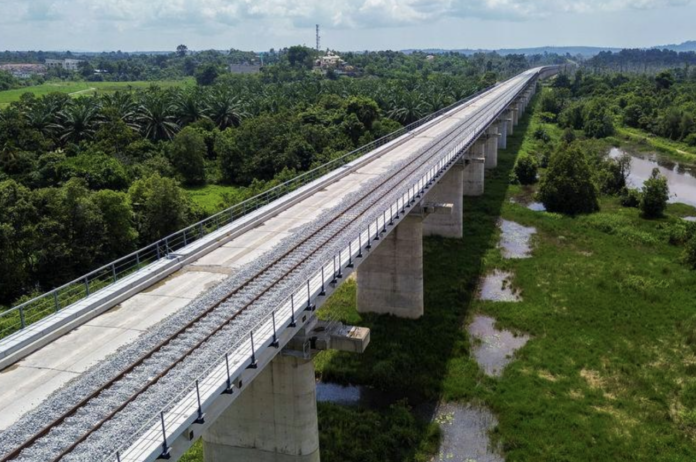KUALA LUMPUR, June 19 – The construction work for the 665-kilometre-long East Coast Rail Link (ECRL) project has been running smoothly and reached 67% completion despite several hiccups and challenges throughout its development and implementation phases.
Aimed at improving connectivity and stimulating economic development, the project traversing Kelantan, Terengganu, Pahang and Selangor, is set to be an economic game changer especially in boosting Malaysia’s transportation network. It is expected to be completed by the end of 2026.
The massive infrastructure project, which connects the east and west coasts of the country with 20 stations, is also a testament to the strong bilateral relationship between Kuala Lumpur and Beijing.
The project which cost RM50.2 billion notched another milestone with the groundbreaking ceremony for the ECRL Gombak Integrated Transport Terminal (ITT) Station officiated by Prime Minister Datuk Seri Anwar Ibrahim and the visiting China’s Premier Li Qiang, on Wednesday.
Speaking to Bernama, Malaysia Rail Link Sdn Bhd Chairman Tan Sri Mohd Zuki Ali said the presence of Li Qiang at the groundbreaking ceremony reflects a strong bilateral relationship between two longstanding partners which ensures the successful implementation of the project under Beijing-led Belt and Road Initiative (BRI).
It is the first groundbreaking ceremony held in Selangor and also marks the beginning of construction for the first station for the ECRL line in the state, which will have a total of five stations, he said.
“This station will serve as the main gateway to the capital city, facilitating ECRL users’ travel from Klang Valley to the East Coast states or vice versa. ECRL will also be connected to the Kelana Jaya LRT Line at Gombak Integrated Terminal, providing a better network and greater passenger capacity.
“The ECRL line, from Kota Bharu in Kelantan to Gombak in Selangor is expected to be completed by the end of 2026 and operational by January 2027. Travelling time between Kota Bharu to the Klang Valley is anticipated to be around four hours compared to seven hours or more by road during festive seasons. Overall, the progress of the ECRL project is at 67%,” he said.
Speaking to the media in April, Transport Minister Anthony Loke said the ECRL network in Selangor which spans nearly 120 kilometres will have five stations namely Gombak, Kapar and Jalan Kastam Integrated Terminals for passengers only while the Bandar Serendah and Puncak Alam stations are connecting stations for passengers and cargo.
The construction phase for the ECRL project began with the groundbreaking ceremony in Kuantan, Pahang in August 2017, but the work was suspended in 2018 for financial reasons before work for the project resumed again in July 2019 at a lower cost.
The ECRL connects state capitals, major urban centres, industrial hubs, ports, airports, and tourism zones and interchanges with existing railway lines in Peninsular Malaysia.
The project is owned by MRL, a wholly owned subsidiary of the Minister of Finance (Incorporated), while China Communications Construction Company (CCCC) serves as the main contractor for the project.
Malaysia Institute of Transport (MITRANS) Director Prof Madya Ts Dr Wan Mazlina Wan Mohamed told Bernama that ECRL is a crucial national infrastructure project to boost regional development, connectivity and improving public transit across its electrified railway network, connecting urban and rural areas.
It also reduces environmental pollution by transitioning from the use of fuel-based vehicles to an electrified rail network and provides a safe alternative mode of public transport for long-distance journeys, said Wan Mazlina.
Meanwhile, Investment, Trade and Industry Minister Tengku Datuk Seri Tengku Zafrul Abdul Aziz was quoted by the media in March this year as saying that ECRL serves as a catalyst for socioeconomic growth and is expected to increase the country’s Gross Domestic Product by 3.78% by 2047.
“The ECRL is poised to be a game changer for Malaysia, linking us more closely to the Pan-Asia railway network and enhancing our connectivity with ASEAN and Eurasia regions,” said Tengku Zafrul in his keynote address at the Seminar on East Coast Rail Link – Economic Accelerator Project (ECRL–EAP) Business and Investment Opportunities.
Meanwhile, Bank Muamalat Malaysia Bhd Chief Economist Dr Mohd Afzanizam Abdul Rashid said that, once completed, the ECRL project will benefit the real estate sector, among others, due to the effects of urbanisation and the increase in property prices.
Malaysian Investment Development Authority (MIDA) in April said the ECRL-EAP is anticipated to generate RM1.4 trillion for Malaysia’s economy by 2047 with a focus on industrial parks, logistic hubs and transit-oriented developments.
Given that the project is the largest ever to be undertaken along the East Coast alignment, it would be ideal for companies to seize opportunities that arise, with areas that could be further explored including renewable energy; sustainability products and services; education and training centres, said MIDA.
















